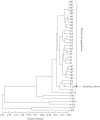Genetic diversity and origin of weedy rice (Oryza sativa f. spontanea) populations found in North-eastern China revealed by simple sequence repeat (SSR) markers
- PMID: 17056615
- PMCID: PMC3292271
- DOI: 10.1093/aob/mcl210
Genetic diversity and origin of weedy rice (Oryza sativa f. spontanea) populations found in North-eastern China revealed by simple sequence repeat (SSR) markers
Abstract
Background and aims: Weedy rice (Oryza sativa f. spontanea) is one of the most notorious weeds occurring in rice-planting areas worldwide. The objectives of this study are to determine the genetic diversity and differentiation of weedy rice populations from Liaoning Province in North-eastern China and to explore the possible origin of these weedy populations by comparing their genetic relationships with rice varieties (O. sativa) and wild rice (O. rufipogon) from different sources.
Methods: Simple sequence repeat (SSR) markers were used to estimate the genetic diversity of 30 weedy rice populations from Liaoning, each containing about 30 individuals, selected rice varieties and wild O. rufipogon. Genetic differentiation and the relationships of weedy rice populations were analysed using cluster analysis (UPGMA) and principle component analysis (PCA).
Key results: The overall genetic diversity of weedy rice populations from Liaoning was relatively high (H(e) = 0.313, I = 0.572), with about 35 % of the genetic variation found among regions. The Liaoning weedy rice populations were closely related to rice varieties from Liaoning and japonica varieties from other regions but distantly related to indica rice varieties and wild O. rufipogon.
Conclusions: Weedy rice populations from Liaoning are considerably variable genetically and most probably originated from Liaoning rice varieties by mutation and intervarietal hybrids. Recent changes in farming practices and cultivation methods along with less weed management may have promoted the re-emergence and divergence of weedy rice in North-eastern China.
Figures




References
-
- Arrieta-Espinoza1 G, Sánchez1 E, Vargas S, Lobo J, Quesada T, Espinoza AM. (2005) The weedy rice complex in Costa Rica. I. Morphological study of relationships between commercial rice varieties, wild Oryza relatives and weedy types. Genetic Resources and Crop Evolution 52575–587.
-
- Baker HG. (1974) The evolution of weeds. Annual Review of Ecology and Systematics 51–24.
-
- Belkhir K. (1999) GENETIX, Version 4·02 a Windows program for population genetic analysis(Laboratoire Genome, Populations: interactions UPR 9060 du CNRS, Universite Montpellier 2, Montpellier, France).
-
- Bowcock AM, Ruíz-Linares A, Tomfohrde J, Minch E, Kidd JR, Cavalli-Sforza LL. (1994) High resolution human evolutionary trees with polymorphic microsatellites. Nature 368455–457. - PubMed
-
- Burger JC, Lee S, Ellstrand NC. (2006) Origin and genetic structure of feral rye in the western United States. Molecular Ecology 152527–2539. - PubMed

